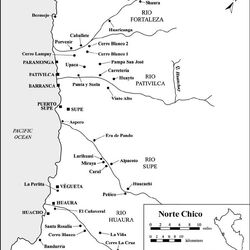
A map highlighting cities in Norte Chico
In recent years, it has become more and more clear that the history of the Americas stretches as far back, if not further than that of the Old World. In particular, evidence in Peru indicates that the Norte Chico civilization has a history stretching back nearly 6,000 years, making it one of the oldest civilizations on Earth, with a history as long as China, Egypt, or Mesopotamia. However, age is where the similarities between Norte Chico and the old world end. Unlike the great civilizations of the Old World, ancient Peru had very limited options in terms of domesticable land animals to provide a source of protein. With limited options, the ancient Peruvians came up with a novel system—they relied almost exclusively on fish for their protein, making the cotton to produce them one of their most crucial crops.
While the exact circumstances that lead to the decline of Norte Chico are unclear, it's likely that the reliance on one source of protein put a hard cap on the population that was eventually reached. However, this was hardly the only way Norte Chico might have ended. Despite their stellar progress in some areas the ancient Peruvians never developed technologies that might have raised their population ceiling by streamlining their food production and storage, such as pottery better irrigation, and even wheels. Instead of fizzling out and only leaving traces of their unique civilization, the ancient Peruvians of Norte Chico might have grown and exported their culture across the continent, jump-starting civilization in the Western Hemisphere by simply reinventing the wheel.
Points of Divergence[]
Despite the current focus on the alternate development of Norte Chico, this timeline will include a secondary point of divergence concerning Ming China, and may include more in the future. Without further ado, here are the ways this world diverges from our timeline:
- Peru, Circa 2200 BC — Archeological records indicate that by this time the early Fusangians that would become the Kotosh Culture had invented pottery and the wheel in tandem with more sophisticated irrigation. The subsequent population boom and expansion would turn the Kotosh from a small culture on the coast into a sprawling society that would soon spread across the Western Hemisphere...
- Ming China, 1426 AD — Despite the expense, the Jiajing Emperor of Ming China opts to continue to maintain the dynasty's famed treasure fleet. In the short term, this brings the dynasty to the financial brink, but in 1442 this starts to change, while when searching for potential tributaries in the southern ocean, the fleet's commander starts to hear rumors of a distant land to the East...
Contributors[]
If you're interested in contributing, please contact Firesofdoom. There's no procedure for this yet, so all decisions will be made on a case-by-case basis. Current contributors are listed below.
- Firesofdoom (Editor, Creator)
Footnotes[]
| |||||||||||||||||||||||||||

